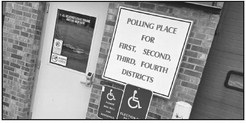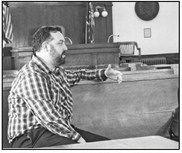Looking ahead to issues and opportunities of the coming year


Star News
Editorials
Looking ahead to issues and opportunities of the coming year As we learned in elementary school, a year is 365 days long.
It is 365 opportunities to show leadership, to bring about positive change in our communities, to grow as individuals, to learn and to live.
The new year marks a symbolic new beginning. It is the renewal of the hope and promise that exists within each of us as human beings.
When planning any lengthy journey, such as the one that stretches before all of us over the coming year, it pays to attempt to look ahead and to prepare for those challenges and opportunities that lie ahead.
As the French scientist Louis Pasteur wrote, “Fortune favors the prepared mind.” In a similar way it is important to be prepared for what will come in the coming year to impact our communities.
Leadership
There are different kinds of leadership. There are those who have authority based on their position in an organizational chart. Others are deferred to as being experts in their specific area or especially knowledgeable on a topic.
Taylor County faces a challenge of leadership on the day-to-day operations of the county.
This is nothing new. County governance is intentionally non-centralized to prevent one individual from assuming too much power and authority. Elected officials have chosen the comparative inefficiency of having multiple departments and an independent very active committee system as being preferable to finding out after the fact that a non-elected bureaucrat was carrying their own agenda that was at odds with what the people want and desire.
This worked, to a degree, when you had longtime staff members who had a firm knowledge about how they fit into the county’s organizational structure. In recent years the county has seen the “old guard” being replaced with new individuals, including ones who have come from the private sector or other government agencies with more formalized management structures.
There is a growing push among some county board members to go to a formal county administrator position. However, this would result in a substantial reduction in the power of the county board members and particularly the department chairpersons. Other options that have been proposed include enhancing the duties of the administrative coordinator/ human resources director position to give that individual additional authority in dealing with day-to-day operational management.
Regardless of what the county board ultimately decides, something needs to be done to address the lack of management cohesion so that the county governance does not fracture into competing “kingdoms” of control.
Economy
In the past few years, Taylor County has witnessed a growth in real wages unlike any that has been seen here for decades.
Taylor County, unlike other parts of the nation, never stopped working through the pandemic. Its factories were kept busy producing goods for export around the nation and world.
The area also was spared the worst aspects of the spike in housing costs and other inflationary issues when compared to other regions. Yes, housing costs more than it did 10 years ago, but unlike other regions where rising costs have exceeded rising wages, Taylor County is still ahead of the game making this area a proverbial “sweet spot” for future growth and expansion.
Additional money circulating in the local economy is a benefit to commercial expansion and growth in the region. Downtown areas such as in Medford, Gilman and elsewhere in the county are poised to see a potential renaissance with long-vacant buildings seeing new life and redevelopment of areas around the community.
Looking ahead to the coming year, local government must continue to work in partnership with businesses to bring rebirth to the downtown areas and ensure the health of all commercial districts. Too often, local government appears to work at odds with commerce, throwing up barriers and delays. In order to continue to ride the wave of economic success, local and county government must be partners with commerce.
Demographics
Taylor County, like much of rural America, is sitting on a ticking demographic time bomb. Rural America is getting older. Each year, a growing percentage of the local population ages out of the workforce through well-earned retirement. There are fewer young people in communities to take those positions, not only in workplaces but in groups and organizations.
Historically, rural America has always been the source of labor for larger areas. However, the era of farm families routinely having a dozen children have long since passed.
Civic and community leaders must work to reverse these demographics trends and look at ways to bring young people back to rural America. Local economic development efforts have routinely used the tool of providing incentives to developers for bringing factories and jobs to areas. Local, regional and state leaders must be willing to explore incentive programs to bring people to relocate to the community.
There is some historical precedence for this. In the post cut-over era of Wisconsin history recruiting people from “the old country” to come to settle in rural Wisconsin was a thriving industry. In order to continue to thrive, Wisconsin needs to look at ways to bring this type of boosterism back to the forefront.
State politics
Looking ahead to the coming year, it is time for statewide leaders to end the gotcha-last bickering and instead come together for common ground.
For the past four years, legislative leadership has operated on a belief that if they ignored the governor long enough, he would go away. This didn’t work out so well for them and there appears to finally be realization that Evers will be around for a while — or at least the next four years anyway.
There are some hard choices facing the state government over the next year, foremost of which will be what to do with the state’s obscenely large surplus.
Taxes are the fees we all pay to live in a functioning society. Ideally what is paid in will cover the costs of services and infrastructure with a little extra to be banked for lean times.
Wisconsin must use care that they don’t enact long-term changes in things such as tax law to commit funds that were largely due to one-time windfalls. The state must exercise fiscal responsibility and balance any possible tax breaks with the long-term commitments that exist.
In order to achieve this, Wisconsin leaders must set aside political rancor and work together for the common good to move Wisconsin ever forward Happy New Year. It is time to take off the party hats. Put away the tinsel and noisemakers and get to work.
There is a lot to be a done this year and only 360 more days to do it.




